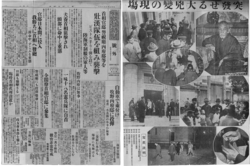Inukai Tsuyoshi
This article includes a list of general references, but it lacks sufficient corresponding inline citations. (May 2017) |
Inukai Tsuyoshi | |||||
|---|---|---|---|---|---|
犬養 毅 | |||||
 | |||||
| Prime Minister of Japan | |||||
| In office 13 December 1931 – 15 May 1932 | |||||
| Monarch | Hirohito | ||||
| Preceded by | Wakatsuki Reijirō | ||||
| Succeeded by | Takahashi Korekiyo (Acting) | ||||
| More... | |||||
| Personal details | |||||
| Born | 4 June 1855 Okayama, Japan | ||||
| Died | 15 May 1932 (aged 76) Tokyo, Japan | ||||
| Resting place | Aoyama Cemetery, Tokyo, Japan | ||||
| Political party | Rikken Seiyūkai (1924–1932) | ||||
| Other political affiliations | Rikken Kaishintō (1882–1894) Chūgoku Progressive Party (1894–1896) Shimpotō (1896–1898) Kenseitō (1898–1910) Rikken Kokumintō (1910–1922) Kakushin Club (1922–1924) | ||||
| Spouse | Inukai Chiyoko (1865–1952) | ||||
| Children | Inukai Takeru | ||||
| Alma mater | Keio University | ||||
| Signature |  | ||||
| Japanese name | |||||
| Kanji | 犬養 毅 | ||||
| Hiragana | いぬかい つよし | ||||
| |||||
Inukai Tsuyoshi (Japanese: 犬養 毅, 4 June 1855 – 15 May 1932) was a Japanese statesman who was prime minister of Japan from 1931 to his assassination in 1932. At the age of 76, Inukai was Japan's second oldest serving prime minister, after Kantarō Suzuki whose term ended at the age of 77.
Early life
Inukai was born 4 June 1855, in Kawairi, Kaya, Bitchū Province (in present-day Okayama, Okayama Prefecture), the second son of Inukai Genzaemon, a samurai, district magistrate and local official (ōjōya). His family was a branch of the Itakura clan, and were originally given a status that allowed them to wear a katana by the Niwase Domain.[1]
In 1876, Inukai travelled to Tokyo and subsequently graduated from the Keio Gijuku (now Keio University) where he specialized in Chinese studies. In his early career, Inukai worked as a journalist for the Yūbin Hōchi Shimbun (now a sports newspaper subsidiary of the Yomiuri Shimbun) and Akita Sakigake Shimpō. He went with the Imperial Japanese Army to the front during the Satsuma Rebellion as a reporter.
Political career
Inukai was first elected to the
Inukai's first cabinet post was as
Inukai returned to the cabinet as Minister of Communications in the second Yamamoto Gonnohyōe administration from 1923 to 1924. He was concurrently Education Minister again for a four-day period in September 1923
In 1922 the Rikken Kokumintō became the Kakushin Club, and joined forces with other minor parties to form the cabinet during the premiership of Katō Takaaki in 1924. During his time, Inukai served on the cabinet again as Minister of Communications. The Kakushin Club then merged with the Rikken Seiyūkai, and Inukai continued as a senior member.
In July 1929, Inukai travelled to
As Prime Minister

Following the resignation of the
Inukai immediately took steps to inflate the economy and to take Japan off the
However, Inukai was forced to accede to a request by the
On 8 January 1932, a Korean independence activist named Lee Bong Chang attempted to assassinate Emperor Hirohito in the
However, Inukai still came under strong criticism for his efforts to rein in the military, while reformists criticized him for not going far enough. Inukai's efforts to limit further troop deployments to China and to defuse the Shanghai Incident through negotiations with the Chinese government drew increasing ire from the general public as well as the militarists. This soon metamorphosed into terrorist activity with the
.On 1 March, the state of Manchukuo was formally proclaimed. Symbolically, Inukai withheld formal diplomatic recognition as a gesture of displeasure against the radical faction within the Imperial Japanese Army, and out of concern due to the rapidly worsening international relations with the United States, on which country Japan depended for much of its raw materials and capital investment.[8]
Assassination

Inukai's struggle against the military led to his
Inukai's third son was writer, politician and post-war Minister of Justice Inukai Takeru. His great-granddaughter was Sadako Ogata, who served as United Nations High Commissioner for Refugees from 1991 until 2001.
Honours
From the corresponding article in the Japanese Wikipedia
- Grand Cordon of the Order of the Rising Sun (September 1920)
- Grand Cordon of the Order of the Rising Sun with Paulownia Flowers (May 1932; posthumous)
References
- ISBN 0-06-093130-2
- Fogel, Joshua A (1996). The Literature of Travel in the Japanese Rediscovery of China, 1862–1945. Stanford University Press. ISBN 0804725675.
- Large S. S. (2001). Nationalist Extremism in Early Showa Japan: Inoue Nissho and the 'Blood-Pledge Corps Incident', 1932. Modern Asian Studies 35(3): 553-564.
- Lee, To Yee (2011). Sun Yat-Sen, Nanyang and the 1911 Revolution. Institute of Southeast Asian Studies. ISBN 978-9814345460.
- Oka Yoshitake, et al. Five Political Leaders of Modern Japan: Ito Hirobumi, Okuma Shigenobu, Hara Takashi, Inukai Tsuyoshi, and Saionji Kimmochi. University of Tokyo Press (1984). ISBN 0-86008-379-9
- Ozaki, Yukio. (2001). The Autobiography of Ozaki Yukio: The Struggle for Constitutional Government in Japan (translated by Fujiko Hara). Princeton: ISBN 978-0-691-05095-9
- ISBN 0-375-70808-1
- ISBN 0-8129-6858-1.
- Tran, My-Van (2005). A Vietnamese Royal Exile in Japan: Prince Cuong De (1882–1951). Routledge. ISBN 0415297168.
- OCLC 424555947.
- ^ Ozaki, Autobiography, pp. 177–184.
- ^ Lee. Sun Yat Sen. Page 64
- ^ Tran, A. Vietnamese Royal Exile in Japan. Page 95
- ^ Fogel, The Literature of Travel. Page 227
- ^ Hirohito, p. 246.
- ^ Bix. Page 247
- ^ a b c Bix. Page 249–252
- ^ Toland, The Rising Sun: The Decline and Fall of the Japanese Empire, 1936–1945
- ISBN 9780719003523.
- ISBN 9788184302080.
